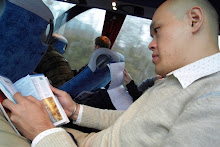You see, as his company trimmed the workforce, he is being asked to cover what used to be others' work. As such, being fearful of retrenchment, my friend needs to be effective and efficient in his work. As a result, his workload increases and so does his stress level.
In view of this, it is said that the government is encouraging firms to focus even more on work-life harmony. I believe in Schools, this is even more essential.
My argument is this. There are certain industries, where being stressed up doesn't help. Pilots, surgeons, and education; just to name a few that comes to mind.
If you are onboard a plane, you want to know that the pilot is free from stress and is able to effectively get you safely to where you want to be.
If you are lying on the operation table, the last thing you want to know is that the doctor is not under pressure to meet KPIs that might compromise his performance during the operation.
In Schools, you want to know that your child's teacher is not hard-pressed to do 1001 things that are beyond their classroom duties.
I believe every job has its challenges and the ability (or expectations) to not only cope with these challenges but to excel and perform in a peak state requires a two-pronged approach.
Firstly, the management of an organization must first recognize what they can do to maintain or achieve this state called "work-life harmony". Schools have increasingly adopted the PIES approach, where the Well-Being Committee looks into the physical, intellectual, emotional, and social (or spiritual) domains. Some have similar approaches such as the EPMS (emotional, physical, mental, and social).
With this approach, or how the School defines the domains of Well-Being, the Committee is then able to introduce ways to address these different domains. For instance, we share with Schools that they can use the 4-D Approach (TM) in its deployment and review.
First, they need to Define what are the needs under each domain. What might be the physical needs, for instance? Here, we need to establish what these needs are. Would it be needs in the area of being and staying healthy? Let's say, for physical we are focusing on how our staff can stay healthy and with that what kind of benefits does it accrue to the individual and also to the School?
We may suggest that by being healthy; it not only contributes to the physical well-being of our staff but they also feel more energetic and confident. That way our staff will be better able to relate to the children. Another dimension could be that they become role-model to the students. And also it would lead to them taking fewer medical leave and hence lesser disruption to the classes.
Hence, once these needs are identified we can then look at how to Design programs or activities to drive it. We could adopt a eat-fruits day or having an exercise friday or simply through raising awareness of eating healthier food. Once these range of activities have been identified, we could then open it up for participation.
Recognizing that kicking a ball may not be everyone's cup of tea; with this range of activities we can then allow staff to pick and choose which activities suit them better. With that, the Delivery of our programs will be centered around how each program can best reach out to our audience. And hence giving us the flexibility to integrate some of these activities with existing ones. For instance, some simple stretching exercise or health talks can be integrated with the morning assembly programs.
Finally, after the delivery, it is now time to Determine the effectiveness of the programs and activities and that calls for different tools. It could be feedback, participation rates, outcome indicators, etc. Main point is, we need to know what's good and what can be done better.
Of course all these can be instituted but more importantly is the second-prong that needs further evaluation. The second-prong requires everyone to practice Habit 7: Sharpening the Saw. Unless everyone undertake this habit and adopt it as a way of life; the programs at best will encourage individuals to take this seriously.
So, let's us start the new month with a goal to at least address one dimension a week in the PIES domain. Beginning with week-one for physical, week-two for intellectual, week-three on emotional, and week-four on social (spiritual).
*You may combine emotional (self) and social (engaged) for week-three and allowing week-four for spiritual (meaning address your purpose in life).
Your friend,
Melvyn
(Sent from my Blackberry Bold)




No comments:
Post a Comment